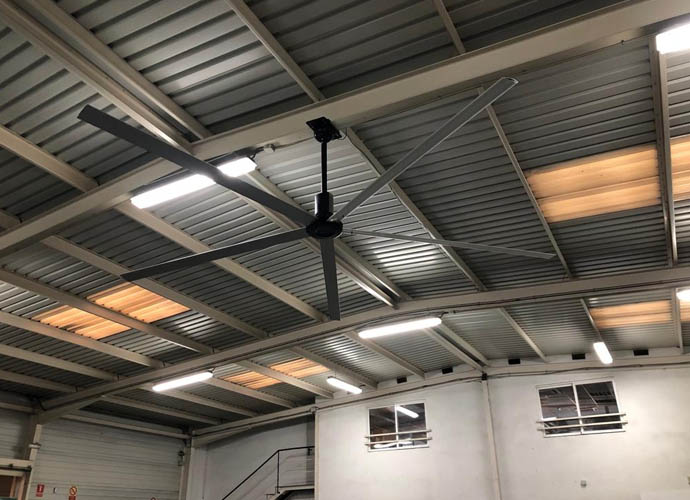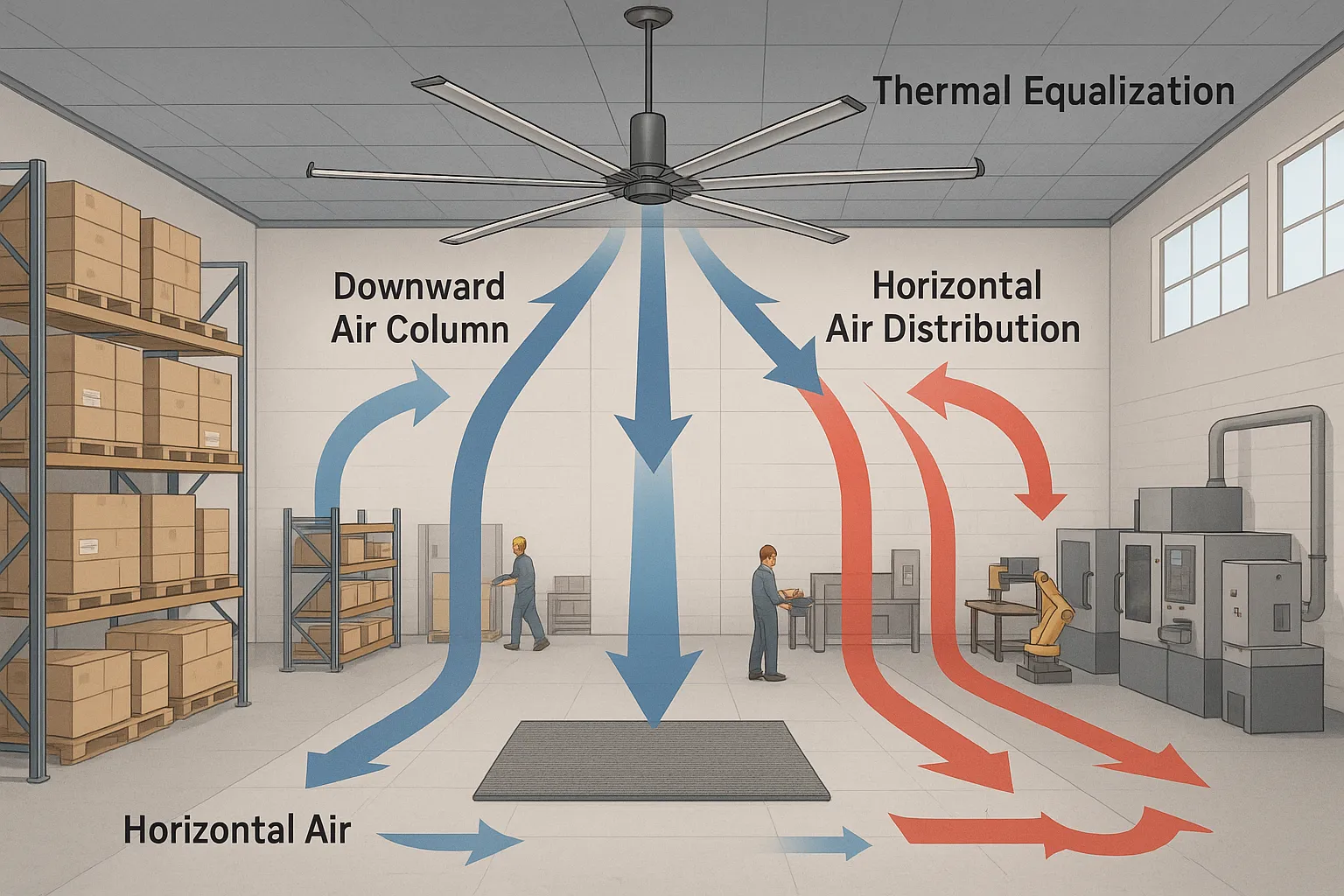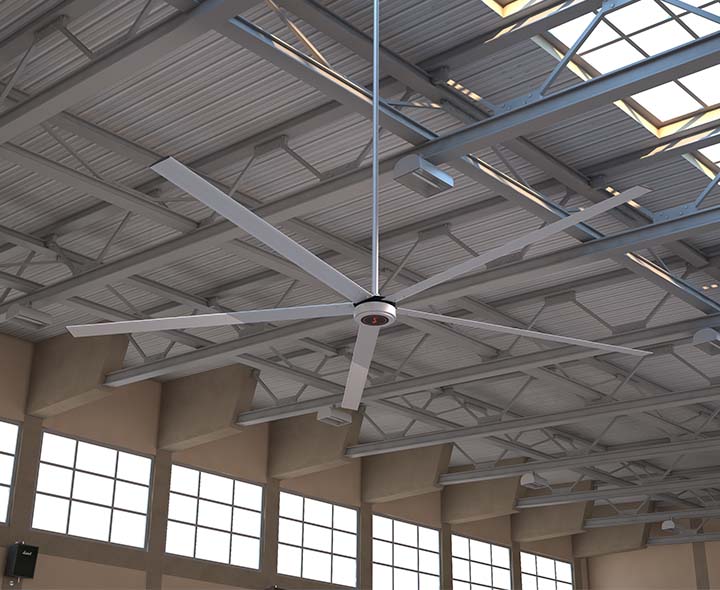Too hot in summer, freezing in winter, and stuffy air all year round? Many factories and warehouses lose productivity and rack up high energy bills simply because they lack the right airflow. The answer: an industrial ceiling fan designed for big, challenging spaces.
An industrial size ceiling fan—also called an HVLS (high-volume, low-speed) fan—is a powerful ceiling fan engineered for large commercial and industrial spaces. These fans move huge volumes of air, stabilize temperature, cut energy costs, and improve comfort across thousands of square feet.

industrial ceiling fan for factory warehouse
文章提纲
- What Makes an Industrial Ceiling Fan Different?
- How Do HVLS Fans Improve Air Movement in Warehouses and Factories?
- Which Industrial Fan Size Is Best for Large Spaces?
- What Are the Benefits of Using HVLS Ceiling Fans?
- How Do Industrial Ceiling Fans Reduce Energy Costs?
- How to Choose the Right Ceiling Fan for Your Facility
- DC Motor Ceiling Fans vs. AC: Which Offers Better Efficiency?
- How Does Regular Maintenance Keep Industrial Fans Performing?
- What Features to Look for in a Heavy-Duty Ceiling Fan?
- Are There Stylish Options for Large Industrial Fans?
- Case Study: Warehouse Airflow Transformation
- FAQs About Industrial Ceiling Fans
What Makes an Industrial Ceiling Fan Different?
Not Your Ordinary Ceiling Fan
Most homes use ceiling fans for local comfort. But in factories, warehouses, and gyms, traditional fans simply can’t handle the demands of industrial and commercial environments. This is where 工业吊扇 shine.
Key Differences:
- 尺寸和功率:
Industrial ceiling fans range from 8 to 24 feet in diameter, while home fans rarely exceed 5 feet. The massive fan blades on an HVLS fan are specifically designed to move air over large spaces with high ceilings—sometimes as high as 40 feet!
- Construction:
Built with robust aluminum or composite blades, sealed heavy-duty motors, and reinforced mounting systems, industrial fans are designed to withstand dust, humidity, temperature swings, and non-stop operation.
- Functionality:
Features like variable speed, integrated LED lighting, and remote or wall controls make them not only more powerful but also more flexible for a range of commercial and industrial settings.
“Industrial ceiling fans are designed to handle the unique air circulation challenges in large commercial and manufacturing facilities, ensuring a safer and more productive work environment.”
对照表:
| 特征 |
Home Ceiling Fan |
工业吊扇 |
| Typical Blade Span |
3–5 ft |
8–24 英尺 |
| 电机类型 |
AC/DC, low power |
Heavy-duty, VFD/EC/DC |
| Airflow Coverage (sq ft) |
150–400 |
2,000–30,000+ |
| Maintenance Needs |
低的 |
Low (with periodic checks) |
| Operating Hours |
Intermittent |
连续的 |
| Typical Application |
Living Room, Office |
Factory, Warehouse, Gym, Barn |
Explore industrial solutions:
See real applications at 用于制造业的工业吊扇 和 仓库 HVLS 风扇.
How Do HVLS Fans Improve Air Movement in Warehouses and Factories?
In large industrial and commercial spaces, stagnant air is a common problem—especially in high-bay warehouses and big factories with complex layouts.
How HVLS Fans Work:
- High Volume, Low Speed:
Unlike small, high-speed fans, HVLS ceiling fans use huge blades to move vast amounts of air slowly and smoothly, creating a gentle “air lake” effect.
- 均匀的空气分配:
These fans are engineered to break up thermal stratification (hot air rising, cold air sinking) by mixing the air throughout the entire space. This means fewer hot/cold spots and improved overall comfort.
- Improved Indoor Air Quality:
Proper air circulation helps reduce humidity, lower airborne dust, and eliminate stuffy air—creating a safer and more pleasant workplace.
Key Benefits for Facilities:
- Perfect for Warehouses:
HVLS fans are the go-to solution for large spaces like warehouses, distribution centers, and logistics hubs, where they keep inventory dry and workers cool.
- Barns and Gyms:
Large barns and fitness centers benefit from reduced humidity, better odor control, and less condensation, thanks to strong air movement.
Airflow Chart:
| 风扇直径 |
Typical Coverage Area |
最佳应用 |
| 8–12 英尺 |
2,000–6,000 sq ft |
Small warehouses, gyms, barns |
| 14–18 英尺 |
6,000–15,000 sq ft |
Large warehouses, manufacturing |
| 20–24 英尺 |
15,000–30,000 sq ft |
Airports, logistics, sports centers |

warehouse airflow chart
Which Industrial Fan Size Is Best for Large Spaces?
选择正确的 工业吊扇 size is crucial for maximizing air movement and energy efficiency. The choice depends on your building’s square footage, ceiling height, layout complexity, and even the type of work environment.
How to Choose Fan Size by Space
- Warehouses and Distribution Centers:
Large open spaces with high ceilings—typically 20 feet or higher—usually require 16-foot to 24-foot HVLS fans. For example, a 16-foot fan can efficiently cover up to 12,000 sq ft, while a 24-foot fan can move air across 30,000 sq ft or more.
- 健身房和体育中心:
These environments benefit from fans in the 12-foot to 20-foot range, depending on layout and the presence of obstacles like bleachers or equipment.
- Manufacturing Plants:
Factories with lots of machinery and workstations may need several strategically placed HVLS fans (8–20 foot) for even coverage.
Quick Reference Table:
| 空间类型 |
Typical Ceiling Height |
Recommended Fan Size |
Air Coverage (sq ft) |
| Small Warehouse |
14–18 英尺 |
8–12 英尺 |
2,000–6,000 |
| Mid-size Gym |
16–25 ft |
12–16 ft |
6,000–12,000 |
| Large Manufacturing |
20–40 ft |
16–24 ft |
12,000–30,000+ |
Tip:
For buildings with obstructions or unique layouts, use a mix of 定向风扇 and large ceiling fans for the best air movement solutions.
What Are the Benefits of Using HVLS Ceiling Fans?
HVLS 吊扇 go far beyond traditional fans in delivering comfort and savings for industrial and commercial spaces.
Main Benefits:
- Energy-Saving:
Lower air conditioning and heating costs by 20-30%. These large commercial fans redistribute conditioned air, reducing the need for constant HVAC operation.
- Worker Comfort:
Stable air movement prevents hot or cold zones, keeps workers cool in summer, and distributes warm air in winter—critical for productivity and morale.
- Improved Safety and Air Quality:
Proper air circulation helps reduce slippery floors, excess humidity, and airborne dust or fumes.
- 安静运行:
Despite their size, modern HVLS fans deliver powerful airflow with minimal noise, making them perfect for environments where communication is key.
案例研究:
A leading logistics warehouse installed six 20-foot HVLS fans. Within three months, worker complaints about heat dropped by 90%, and monthly energy bills fell by 28%. Maintenance teams reported less dust buildup and improved air quality, supporting a safer work environment.
How Do Industrial Ceiling Fans Reduce Energy Costs?
Energy efficiency is a major driver for industrial and commercial ceiling fan adoption.
How do these fans save money?
- Destratification:
Hot air rises; HVLS fans push this air back down, balancing temperatures across the building. In winter, this means heaters run less. In summer, the breeze allows higher thermostat settings without sacrificing comfort.
- 降低暖通空调负荷:
With stable temperature and less stratification, HVAC systems don’t need to work as hard, reducing wear and extending equipment lifespan.
- 智能控制:
Many modern HVLS fans come with variable speed drives (VFD) and automated systems to adjust speed based on ambient conditions, further optimizing energy-saving potential.
Real-World Data Table:
| 设施类型 |
Energy Cost Reduction |
Fan Quantity |
覆盖范围 |
| Warehouse (100,000 sf) |
25–30% |
6 |
100,000 sq ft |
| Food Processing Plant |
22% |
4 |
50,000 sq ft |
| Sports Complex |
18% |
3 |
36,000 sq ft |
Want to see more numbers?
Compare models and see detailed data at 最佳 hvls 粉丝.
How to Choose the Right Ceiling Fan for Your Facility
Selecting the best industrial ceiling fan means balancing performance, efficiency, durability, and site-specific needs.
Step-by-Step Guide:
Measure Your Space:
Calculate square footage (length x width) and note the ceiling height.
Assess Obstructions:
Columns, racks, or machinery may affect airflow—plan accordingly.
Choose Fan Options:
- Downrod lengthfor high ceilings
- Flush mount ceiling fanfor lower ceilings
- Ceiling fan with lightif illumination is needed
- Ceiling fan with remoteor wall control for convenience
Consider Motor Type:
DC motor ceiling fans offer higher efficiency and quieter operation.
Select Features:
寻找 变速, integrated LED, heavy-duty materials, and relevant certifications.
“The right industrial fan is an investment in workplace comfort, safety, and operational savings. Consult with HVLS specialists to optimize your solution.”
For tailored advice, explore hvls ceiling fans for warehouse 或者 fans for commercial buildings.

How to Choose the Right Ceiling Fan for Your Facility
DC Motor Ceiling Fans vs. AC: Which Offers Better Efficiency?
Choosing between a DC motor ceiling fan and a traditional AC motor is now a key decision for industrial and commercial buyers.
DC Motor Advantages:
- 能源效率:
DC motors use up to 70% less electricity than AC motors, making them the go-to for energy-saving operations.
- Variable Speed:
Most HVLS fans with DC motors offer infinitely variable speeds, ensuring the right airflow for every season or shift.
- 安静运行:
Thanks to brushless design, DC motor fans deliver powerful airflow with minimal noise—ideal for spaces where communication and focus matter.
- Integrated Smart Control:
Many DC fans support VFD (Variable Frequency Drive) technology and can be integrated with building management systems.
对照表:
| 特征 |
DC Motor Ceiling Fan |
AC Motor Ceiling Fan |
| 功耗 |
低的 |
Moderate–High |
| 噪音水平 |
非常低 |
缓和 |
| 控制 |
Variable Speed, Remote |
Basic (Step or Pull) |
| 维护 |
最小 |
缓和 |
| 成本 |
Higher upfront |
Lower upfront |
| 长寿 |
Longer |
Shorter |
For high-volume, low-speed (HVLS) fans, DC is the gold standard for efficiency, especially in 12 foot and 16 foot industrial fans.
How Does Regular Maintenance Keep Industrial Fans Performing?
Even the most robust 工业吊扇 need some basic care for peak performance and longevity.
Maintenance Best Practices:
- Quarterly Inspection:
Check for dust buildup, loose bolts, and proper electrical connections. Dust can reduce airflow and add noise.
- Blade Cleaning:
Clean fan blades regularly, especially in dusty environments like food processing or warehouses.
- Motor Check:
Listen for unusual sounds—DC and modern AC motors should be quiet. If you hear rattling or humming, investigate.
- Control System:
Test remote controls, wall panels, and variable speed settings to ensure full functionality.
“Most HVLS fans are designed for low maintenance, but routine checks help deliver powerful, quiet operation for years—improving ROI and reducing surprises.”
Resource:
Maintenance tips for various models can be found at industrial fans direct.
What Features to Look for in a Heavy-Duty Ceiling Fan?
Not all industrial fans are created equal!
The best fans for commercial and industrial spaces offer a blend of durability, flexibility, and safety.
Must-Have Features:
- Heavy-Duty Materials:
Look for aluminum or composite blades and sealed, weather-resistant motors.
- Variable Speed/VFD Support:
This allows you to fine-tune airflow and save energy.
- Integrated LED Lighting:
Fans with light and remote give you the convenience of workspace illumination and easy operation.
- 安全功能:
Overload protection, anti-drop devices, and reinforced mounting for safer work environments.
- Design Flexibility:
Choose from various styles, finishes (like matte black), and sizes (from 8 foot to 24 foot) to match your industrial design.
For full feature details, visit 超低噪音风扇 和 镀锌吊扇.
Are There Stylish Options for Large Industrial Fans?
Absolutely!
Modern large ceiling fans blend powerful performance with stylish, industrial aesthetic.
Popular Design Trends:
- Matte Black & Custom Colors:
A black ceiling fan complements both rugged industrial spaces and upscale commercial buildings, blending seamlessly with modern home décor or retail environments.
- Flush Mount and Downrod Options:
From ultra-high ceilings to standard spaces, you can choose the mounting style that maximizes both airflow and safety.
- Integrated Lighting & Remote:
Many industrial-style ceiling fans now come with light and remote as standard, combining form and function.
Explore real-life installations:
Check out big commercial ceiling fans for commercial-building.
Case Study: Warehouse Airflow Transformation
Client:
A global e-commerce fulfillment center, 120,000 sq ft, 28-foot ceilings.
Challenge:
Rising summer temperatures caused worker discomfort, equipment overheating, and a spike in cooling costs. Stagnant air also led to condensation on warehouse floors, increasing safety risks.
Solution:
The facility installed eight 20-foot HVLS fans, each equipped with integrated LED and variable speed controls.
Results After 3 Months:
- Air Quality:
Elimination of condensation and stagnant air pockets, creating a healthier work environment.
- Comfort:
Worker satisfaction with climate rose from 64% to 97%, and productivity improved in picking/packing areas.
- Energy Costs:
Monthly HVAC energy expenses dropped by 25%. ROI achieved in less than 14 months.
- Safety:
Fewer slip hazards and a measurable reduction in workplace incidents.
Key Insight:
“Installing HVLS fans was one of the fastest ways to boost both comfort and cost savings in our entire operation. The change was immediate and noticeable.”
FAQs About Industrial Ceiling Fans
How do industrial ceiling fans improve air quality?
They keep air moving continuously, reducing humidity, preventing mold and rust, and helping to remove airborne dust and fumes.
Can HVLS fans be installed in existing buildings?
Yes. Most are designed for easy retrofit with adjustable mounting brackets and various downrod lengths.
Are HVLS fans loud?
No. Modern HVLS fans deliver quiet operation even at maximum speed—typically less than 50 dB at ground level.
How many fans do I need for my facility?
It depends on size, ceiling height, and obstructions. One 20-foot HVLS fan can often replace dozens of small barrel fans or directional fans. Consult a professional for a custom plan.
Can I control several fans at once?
Yes. Centralized remote or wall panels let you control speed, direction, and lighting for multiple fans.
What is the lifespan of an industrial ceiling fan?
With regular maintenance, quality HVLS fans often last 12–15 years or more.
Are outdoor ceiling fans available for barns and gyms?
Absolutely. Choose outdoor-rated models designed to withstand moisture, dust, and temperature changes.
Do fans require regular maintenance?
Minimal, but regular inspections and cleaning are recommended for safe, reliable operation.
Do HVLS fans help in winter?
Yes. By mixing warm air from the ceiling down to the floor, they make heating more efficient and comfortable.
Internal Links for More Resources
关键要点
- 工业吊扇and HVLS fans provide robust airflow, cut energy costs, and create safer, more comfortable work environments in large spaces.
- Choosing the right fan size, motor technology, and features is crucial—consider your facility’s needs and growth plans.
- Regular maintenance is minimal but critical for long-term reliability.
- For customized solutions, partner with a specialist manufacturer.


